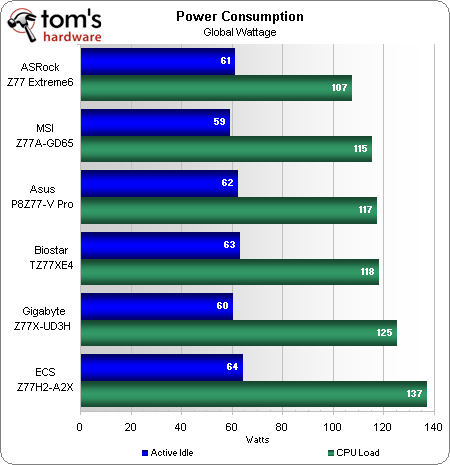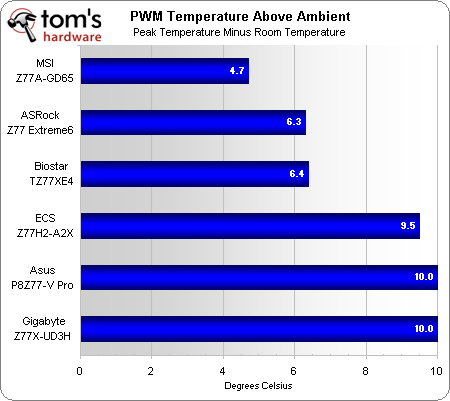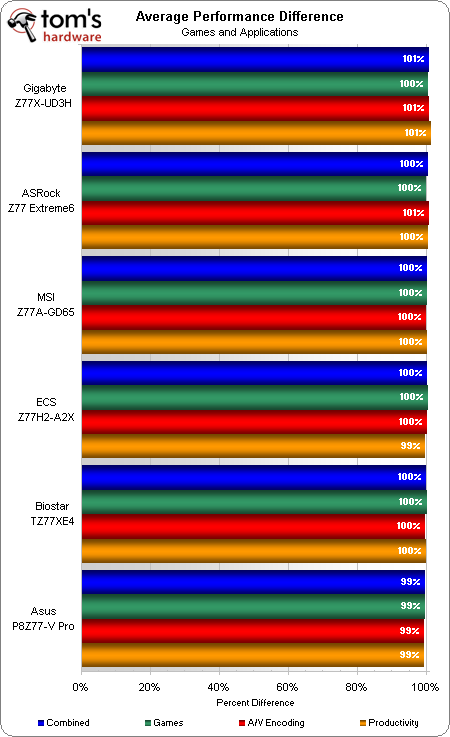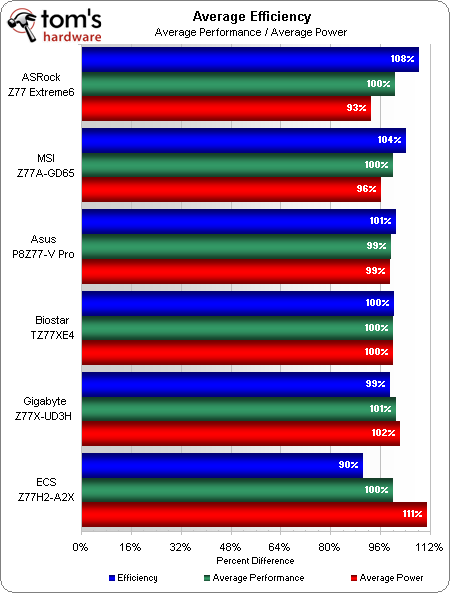Six $160-220 Z77 Motherboards, Benchmarked And Reviewed
Combining the newest features with moderate expandability, Intel’s mainstream platforms provide high value to most gaming and overclocking enthusiasts. We compare six examples with Z77 Express to find the best features, overclocking, and efficiency.
Power, Heat, And Efficiency
ASRock performs an amazing feat in power consumption, beating the most power-hungry board by 30 W at full load. We did our best to assure that each board’s power-savings features were completely enabled for our benchmarks, but some motherboards had a greater number of power options compared to others.
MSI’s low heat signature could be due to superior cooling, but it’s more likely that its unique design did a better job of preventing us from probing a hot spot. With a maximum temperature gain of only 10° Celsius, all of the boards run acceptably cool.
The average performance chart of today’s review compares each motherboard’s overall performance to a class average for all six motherboards. Gigabyte had the highest base clock (which technically goes down as a mild form of cheating), so Gigabyte takes an artificial lead.
ASRock’s low full-load power consumption generates a similarly low average power consumption, giving it an 8% above-average efficiency rating. Vice versa for ECS.
Get Tom's Hardware's best news and in-depth reviews, straight to your inbox.
Current page: Power, Heat, And Efficiency
Prev Page Benchmark Results: Productivity Next Page Overclocking-
yougotjaked There's a typo on the last page. It says X77H2-A2X instead of Z77H2-A2X :P It's on the second to last paragraph...Reply -
HMSvictory I am surprised that you guys did not include the Asus z77-VReply
http://www.newegg.com/Product/Product.aspx?Item=N82E16813131820 -
confish21 One thing i was looking for was the part about asrock not having true "digital" PWM and going with an analog PWM. Does this really matter?Reply -
Crashman TekN9NeGreat review! At the end of day, it comes down to brand loyalty.I don't think the article stated anything like that. It comes down to the features you want and the cards you plan to use. In the MSI vs ASRock debate, it's x8-x4-x4 with all three slots in PCIe 3.0 mode, or x8-x8-x4 with x4 in PCIe 2.0 mode, and you're definitely wiser to pick between them based on WHAT you plan to use in the third slot.simone saysdo you mean nvidia and intel gets news during weekends not only news but featured articles?It's Monday here, and editorial has very little contact with news.HMSvictoryI am surprised that you guys did not include the Asus z77-Vhttp://www.newegg.com/Product/Prod 6813131820Tom's Hardware didn't "include" anything in the review. A couple boards were excluded based on price, and everything else was let in. The P8Z77-V Pro was the cheapest board Asus sent.rickrentswhy not with Pci-e 3.0?Editor had no PCIe 3.0 cards. And the reason he didn't get one yet is because it didn't matter. The only thing that really mattered in a single-GPU MOTHERBOARD comparison was to use the same card on all platforms.confish21One thing i was looking for was the part about asrock not having true "digital" PWM and going with an analog PWM. Does this really matter?Some digital voltage regulators have been garbage, take a look at a few of the older reviews to see this. Very few have been very good. And many more analog voltage regulators have been garbage, while many more analog voltage regulators have been very good. Quality of execution is more important than the underlying technology.Reply




